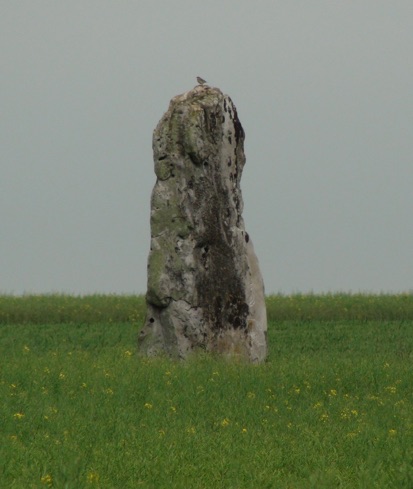Publications on African Art, Prehistory & Evolutionary Theory

My research ranges from the development of new perspectives on human evolution to the discovery and interpretation of prehistoric and tribal art – and covers decades in the field in Africa, North America and Europe.
Recent & future publications
that have cleared peer review:
Please go all the way to the bottom of this page to download my articles by clicking on the little photos, which serve as icons, to the left of the captions.

This beautiful illustration of prehistoric artifacts found by Henry David Thoreau was created by my friend Jeff Boudreau and is shown here courtesy of his widow, Elaine Courtney.
-
-2018 & 2019. ‘Mind Prints, Arrowheads, the Indians & Thoreau’ (2018) & its annex/sequel ‘In the Company of Presentists: Defending Thoreau against Joshua Bellin’s “In the Company of Savagists”’ (2019).
The first of these related essays corresponds to the culminating lecture of a symposium entitled “Uses and Abuses of Thoreau at 200” held at the Department of Literature, History of Ideas, and Religion of the University of Gothenburg, in Sweden on May 3rd & 4th, 2018. It moves from an examination of Thoreau’s relationship with prehistoric artifacts to a demonstration of the ways that collecting them affected his relationship with the natural world, time, and Native Americans. The paper shows that artifact hunting – or “arrowheading” as Thoreau called it - changed his thinking so radically that he moved from seeing the “American Race” as being doomed to seeing it as enduring. More importantly, this essay shows that he died with a cry against the persecution of Native Americans on his lips. Those words would have taken the form of a book in one-to-three volumes that he was planning to write about “arrowheading,” but which would have been as limited to the subject of artifacts as Walden was to describing a pond. Luckily, he left enough journal entries and other texts to reconstruct both the ways arrowheading altered his thinking and the scope of the book, which would have become a monument that would have changed how Thoreau is perceived today.
The second essay owes its existence to the convener of the symposium, Henrik Otterberg, because he felt my presentation (and the above essay) had staked out a position concerning Thoreau’s relationship with Native Americans that was different enough from the one which Joshua Bellin had defined in his paper, “In the Company of Savagists”, that it would be interesting to clarify those differences by commenting on his text. Several scholars, including Bellin, have portrayed Henry David Thoreau as having a blind spot when it came to the persecution and dispossession of Native Americans. Bellin’s paper alleges that Thoreau’s “attempt to forge a radical position beyond his own civilization depended on the bedrock tenet of that civilization, the displacement and recuperation of an Indian Other” (Bellin 2008: 25). Bellin’s declaration that “It becomes evident that the drama of following in aboriginal footsteps enables him [Thoreau] at once to absorb and to expunge the Indians” (p. 22) even makes it sound as if Thoreau were complicit in genocide. My essay’s gloss on Bellin’s seminal paper shows how he developed his argument by ignoring and eliding passages in Thoreau’s works that disprove his contention that Thoreau never expressed indignation about the abuse of Native Americans or stood up in their defense. By examining Bellin’s omissions and rhetorical tactics, my article shows how his case against Thoreau is grounded in a presentism that ignores prominent evidence against such an approach to understanding Thoreau’s stance on these complex issues.
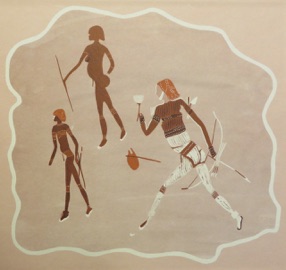
-
-2019. Book review of The White Lady and Atlantis, Ophir and Great Zimbabwe: Investigation of an Archaeological Myth. 2016, Jean-Loïc Le Quellec. Rock Art Research, vol. 36, 2 (Nov.), pp 236-241.
This essay examines a well-written and cautionary tale about the ways that archaeological observations were once hijacked and commercialized in the service of racism and colonialism, and the drive that has led some great researchers to jump to unwarranted conclusions.

- 2018. The Magic Trumpeter: A Bakongo Nkisi Nkondi and its links with World War I, the Harlem Hellfighters, and Jazz. RES: Anthropology and Aesthetics, RES 69-70, 2018 edition. University of Chicago & Peabody Museum of Archaeology and Ethnology & Art Museum, Harvard. University of Chicago Press. Inside & outside covers, explanatory cover page, and pp. 269-293.
After examining the history and practices surrounding the most impressive Bakongo statues pierced with metal, which are known as minkondi, the publication analyzes the attachments and hidden structures of one modeled on a soldier. Several of the attachments, including apparent grenades, the regulatory knob from a German lantern used on the Western Front, and a trumpet sold by a New York company that supplied American military musicians during the First World War, were probably obtained in France, where Congolese soldiers fraternized with African-American troops in a sector with so many black soldiers that it was dubbed ‘L’Afrique’.
The article seizes the opportunity presented by the statue and its extraordinary assemblage to tell more about the hundreds of thousands of Africans who were thrown into battle and used in logistical capacities from France to Tanganyika, as well as the story of how those troops mixed with ones from the African diaspora, including musicians like Will Vodery, Tim Brynn, and James Reese Europe, who introduced jazz to Europe, and, by ricochet, back to white Americans. The consequences of those contacts in the midst of fighting in which black men were told to kill whites and exposed to unparalleled violence spawned civil rights and independence movements around the planet.
“The Magic Trumpeter” is beautifully illustrated, since all four of the journal’s color covers - front and back, inside and out - are devoted to its imagery.

-
-2015. The Use of Animals in Birth Protection Rituals and Possible Uses of Stone Figurines from the Central Sahel. African Arts, 2015 winter issue, Vol. 48, No. 4 (Nov.) pp. 14-25. UCLA African Studies Center.
This article investigates stone figurines, which have been repeatedly described by museums and galleries as being Neolithic and coming from the Azawagh Valley in the south-central Sahara, despite a lack of evidence. Many of these sculptures, which are often made of dinosaur bone, represent pregnant women or can be read simultaneously as an animal and expectant mother. The appearance of the statuettes, which do not correspond to anything that has been collected under controlled circumstances, led to an effort both to find where they really come from and how they might have been used.
Thus, two groups were traced with some confidence to the Yatenga in Burkina Faso, a third group was traced to a zone around Mopti in Mali, and a fourth one appeared to be linked to the desert around Agadez in Niger. While the last group might be Neolithic, the age of the other three groups, which overlap stylistically, is probably constrained by the representation in Group II of dromedaries, which only appeared in the three zones at the beginning of the historic era.
The search also revealed the existence of birth protection rituals involving both live animals and anthropomorphic figurines made of animal bones. The revelation of such customs, which include the use of birthing amulets, opens new avenues for research throughout Africa while casting possible light on the figurines, whose groups appear in all but one case to be younger and from different locations than previously thought.
(PDFs of this and most of my other articles can be downloaded, once they’re published, by clicking on the appropriate thumbnail photos I’ve used as icons at the bottom of this page).

- 2015. A New Typological Ordering of Adena Tablets Based on a Deeper Reading of the McKensie Tablet. (Submitted Feb. 29, 2012)
RES: Anthropology and Aesthetics, RES 65/66, 2014/2015 joint edition: 105-127. Peabody Museum of Archaeology and Ethnology & Art Museum, Harvard University Press.
The starting point for this essay was the recognition of unobserved avian heads on the McKensie Tablet. This led to the identification of new motifs, structures and themes on other engraved Adena Tablets, which represent some of the most complex works of early-to-mid Woodland iconography. These new observations reveal new links between tablets while documenting ways that influences flowed and blended within the Adena world.
But the essay’s purpose goes beyond discovering such iconography or re-defining relationships among tablets, since the recursive graphic techniques employed by the Adena – which range from mirroring to radial re-orientation of motifs like Escher to the embedding of symbols within each other – provide a case study in how imagery can grow so allusive that it can embody, encrypt and sustain the twists and turns of a complex ideology – in this case, one that set the template for Woodland beliefs in the Middle Ohio Valley until contact with Europeans.
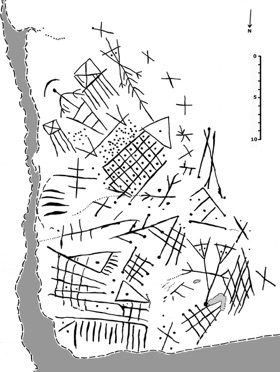
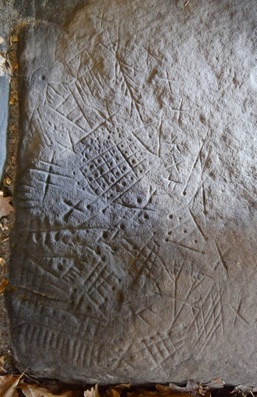
-
-2015. The Implications of a New Corpus of Late Bronze Age Petroglyphs in the Forêt de Fontainebleau for Dating Local Rock Art. Rock Art Research, Vol. 32, No. 2: 178-192. Posted online by IFRAO 28 May 2015.
This article about the discovery of the richest corpus of late Bronze Age petroglyphs in Europe undermines some of the most pernicious ideas about cultural flows in ancient Europe since it provides evidence both that such hackneyed symbols as early swastikas may have been misread and that they were probably not introduced by Bronze Age invaders from the Eurasian steppes. That notion, which was so dear to Nazi “ethnographers”, was ironically recycled by feminist archaeologists like Marija Gimbutas, who argued that the late Bronze Age iconographic package, which includes swastikas, was representative of invaders who overwhelmed such ‘Old European’ cultures as Vinča, which she thought was a Neolithic matriarchy. The new corpus adds so much to what is known of the Bronze Age package that we can see that both swastikas and many of the symbols associated with them are probably derivatives of motifs used by the very cultures that the “patriarchal invaders” supposedly annihilated.
But these distillates only appear after the paper has shown how the petroglyphs, which the author and his colleagues found near Fontainebleau, are closely related to late Bronze Age pictogram vases and more distantly related to earlier Balkan ceramics. Many of the most complex motifs in the new corpus group smaller ones into the apparent equivalent of ideograms. In the process of exploring the relationships between such units and compounds, the article reveals possible links between a gammadion cross, crosses with dots between their branches, grids containing dots, "plowmen" in association with schematics of yoked cattle, and an owl-like figure with a punctuated grid and framed cross on its belly.
Finally, it explores evidence that the petroglyphs overlap the Massif de Fontainebleau’s ‘classic’ rock art style, which represents the vast majority of the zone’s known sites and has often been described as Mesolithic, despite counter-indications. In doing so, it demonstrates that the style may be less than half as old as was thought, subverting yet another dogma.
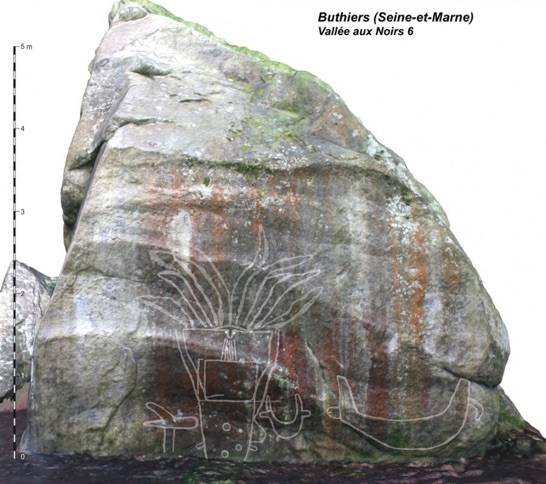
1) 2014. A discovery of exceptional Neolithic engravings in Buthiers, Seine-et-Marne, France.
Antiquity (Antiquity Project Gallery article), Vol. 88, issue 340 (June).
Serge Cassen, Laurent Lescop, Valentin Grimaud, Duncan Caldwell.
2) 2014. Le Rocher Gravé de la Vallée aux Noirs. Buthiers (Seine-et-Marne). Campagne 2013.
Art Rupestre, Bulletin du GERSAR n° 65 (Juin 2014) : 25-37.
Serge Cassen, Laurent Lescop, Valentin Grimaud, Duncan Caldwell.
(A PDF of the second paper can be downloaded by clicking on the thumbnail photo next to the relevant caption at the very bottom of this page).
These two articles describe a newly discovered frieze, which includes, from left to right, an early Neolithic, Bégude-type prestige axe from the Italian Alps, an anthropomorph coifed with ten “plumes”, and two apparent boats. The larger one, which has high angular extremities and a hook that looks like a steering oar or beak, appears to illustrate a complex vessel made of planks, rather than the kind of simple dug-out canoes that have usually been associated with the western European Neolithic. The likelihood that the motif illustrates a boat like a Haida war canoe fundamentally changes our conception of what Europe’s early Neolithic people could do and build, making it much more likely, for example, that they engaged in extensive trade and even whaling.

-
- 2014 (The internet version of the article was posted on Nov. 26, 2013).
An historic sign, possible Mesolithic menhir, DStretch, and problems in dating rock art to the Sauveterrian in the Massif de Fontainebleau.
Co-authored with my intern, Ulrika Botzojorns.
Journal of Archaeological Science (JAS), Vol. 42 (Feb.): 140-151.
This paper uses typological analyses and image-enhancement software to eliminate an engraved and pigmented monolith as a chronological marker for dating the largest concentration of supposed Mesolithic rock art in Europe – the “classic” schematic engravings in the Massif de Fontainebleau. It shows that part of the block, which was thought to have lain undisturbed for over 7,000 years and has been referred to as a “Rosetta Stone” for dating much of the region’s art, actually bears historic letters.
The orientation of these painted letters, whose tops all point towards the block’s narrow end, and absence of both the letters and apparent medieval engravings around the other end indicate that the monolith’s broader end was planted in the soil and more tapered one was exposed when the markings were made. This means that the monolith was upright. The only candidate we could find for keeping it vertical for long on the cave’s sandy floor was an oval cluster of small rounded boulders in the Mesolithic layer underneath, which is over 7,000 years old. If these stones were used to brace the block, its exposed section could have been marked at any time between the monolith’s erection and collapse millennia later. But they also indicate that the monolith could be one of the oldest known menhirs in western Europe.
A free PDF of this paper can be downloaded by clicking on the appropriate icon at the bottom of this page.

Four-month-old red kangaroo joeys like this one, whose name is Skippy, are completely bald. This makes it easier for a kangaroo mother to clean her baby by sticking her snout into her pouch and licking off the joey’s urine and excrement. Courtesy of the Global Wildlife Center.
- 2013. Hair Distribution, Immuno-resistance and Adaptations to the First Baby Slings. (Submitted Dec. 13, 2012)
Anthropologie - International Journal of Human Diversity and Evolution; formerly Anthropologie - International Journal of the Science of Man. Volume 51, Issue 3: 349-374
This essay contains two hypotheses: the first postulates that infectious and parasitic conditions in the first baby-carrying devices or “slings” selected for changes in juvenile hair distribution and immuno-resistance, and that a convergence of datable mutations and osteological changes indicate that infants in our lineage adapted to the microenvironment between 1.2 and 2.8 million years ago - with evidence converging towards the older end of that range. Such slings, which might have been first used to carry gleanings, would have surrounded offspring in dangerous pathogens and parasites. Babies whose fetal body baldness had not disappeared would have had an advantage over infants with previously normal body fur, because adults could clean them better – probably resulting in the neotenic extension of the fetal trait.
The microenvironment might have selected for the elimination of infectious pathways as well. The inactivation of the CMAH gene, which could have provided a pathway for pathogens associated with ungulate and proboscidean hides to infect infants with diarrhea, is explored as a candidate, and multiple ways of testing the hypothesis are described.
The related hypothesis, which is based partly on avian comparisons and milk chemistry, postulates that slings gradually forced adults to focus on the kind of nutrition needed by more slowly maturing infant brains by making their babies more altricial. This might have triggered more scavenging, hunting, and feedback mechanisms that slowly extended the new juvenile hair distribution to adults as part of a whole-body cooling system based on sweat and body baldness while contributing to speciation.
One of the advance readers, Dr. Francesco d'Errico, wrote that “... I found the idea and integrated interdisciplinary way you deal with the question fascinating. It is certainly worth publishing” (email, 12 Jan. 2010).

Rock Art Research, Vol. 30, No. 2 (November): 174-196.
This article identifies two sets of Neolithic symbols from the eastern and western ends of the Sahara, which seem so similar, isolated at their loci, and unlikely to result from parallel evolution, because of the variety and intimate association of the symbols in the sets, that the similarities might indicate a cultural connection; and perhaps even a displacement between 4000 and 3700 BCE, rather than cultural diffusion during the earlier westward spread of pastoralism.
Several observers, including Henri Lhote and Raymond Vaufrey, have already noted individual resemblances between central and western Saharan iconography and Egyptian symbols, such as falcon imagery and rams wearing discs between their horns. But this article argues that the set of similarities is both larger than reported and more concentrated, with several strands of evidence converging on a zone encompassing the Kem-Kem Hamada and Wadi Draa on the Algerian-Moroccan border. While some of these similarities probably derive from the common roots of Nilotic and Saharan cultures during the spread of pastoralism from Nubia to the Maghreb from 6000 to 5400 cal. BCE, others — such as grinding platforms with low relief, inwardly spiralled snakes on their backs, which occur in the western Sahara as part of a tradition of decorated querns, and northern Nubia, where there was apparently no such tradition — might signal a later connection.
The article weighs the probability of a westward contact versus an eastward one around 4000 BCE and speculates that some of the resemblances might represent the arrival in the Nile Valley of refugees who fled the increasing aridity of the 4th millennium BCE by retracing the steps of pastoral ancestors. If this scenario is correct, some of the elements of Egyptian theology that became the prerogatives of royalty and the rationale for kingship, including the Horus-Osiris cycle, arrived from the west as the result of an exodus caused by climate change.
Free PDFs of almost all my articles can be downloaded by clicking on the appropriate icons at the very bottom of this page.

- 2013. A Possible New Class of Prehistoric Musical Instruments from New England: Portable Cylindrical Lithophones.
American Antiquity, Vol. 78, No. 3 (July): 520-535. / Also available through the Cambridge University Press.
With one exception, which has been described as a suspended “kiva bell,” long stone rods have been interpreted throughout the archaeological literature of North America as whetstones or pestles. Two particularly long rods in a collection of prehistoric artifacts from New England raise questions as to the real use of some of these objects. The prevailing interpretations of the two artifacts might be incorrect, or at least incomplete, because the rods lack the kinds of wear that are found on most whetstones or pestles. They also have different acoustical properties from true pestles, which are usually shorter, and are identical in materials, acoustics, and form to probable prehistoric lithophones from the Old World, which can be played on the lap.
The identification of the pair of rods as good candidates for being the first known cylindrical, two-toned prehistoric lithophones from New England, and their apparent linkage to early-to-mid Archaic funerals between 9000 and 5000 BP introduces a new avenue for the study of fossil sounds and rituals in both the region and continent.
(Photo courtesy of the Woods Hole Oceanographic Institute, All rights reserved)

- 2013. Le Visage Gravé du Closeau 12 et ses Implications. Nanteau-Sur-Essonne (Seine-et-Marne) / The Engraved Face of Closeau 12 and its Implications. Nanteau-Sur-Essonne (Seine-et-Marne).
Art Rupestre, Bulletin du GERSAR n° 64 (July): 37-46.
This article revealed the existence of a huge, plumed, Neolithic face on a stela at Le Closeau, Nanteau-sur-Essonne, France. It concluded, on the basis of a comparison of statue-menhirs from Guernsey to Switzerland and other evidence, that the Closeau stela might be one of the oldest engraved Neolithic monuments known in France.
- 2013. Observations et hypothèses sur le site du Paly : Milly-la-Forêt (Essonne)” / Observations and Hypotheses Concerning the Megalithic Site of Paly: Milly-la-Forêt (Essonne).
Art Rupestre, Bulletin du GERSAR (Groupe d’Etudes, de Recherches et de Sauvegarde de l’Art Rupestre), No 63 (January): pp. 29-32.
This paper is the second of two about engravings on the menhir du Paly, which is also known as la Pierre Droite and la Pierre du Paly, and an adjacent quartzite slab. The previous article, which is entitled “Réexamen de Deux Sites à Gravures Piquetées. Milly-la-Forêt (Essonne)” (2012. Art Rupestre, Bulletin du GERSAR No 62: pp. 33-38) focused on doing two things.
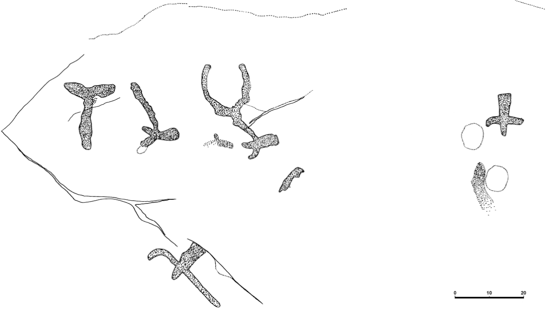
Pecked panel of Butte de Chatillon 5. Tracing by Laurent Valois & Duncan Caldwell, May 2012.
The first was describing a pecked frieze, which I’d found in a cave called Butte de Châtillon 5. The Neolithic panel includes four axes whose shafts hook towards the back of their blades just like the shafts of haches à crosses on stelae in Brittany. But the pair of axes at the center of the top row are astonishing both because they are the only ones that have ever been found upside-down, and because the handle of the central one is surmounted by the kind of U-shaped motif, which is usually interpreted in local Neolithic iconography as being a representation of horns or the necklace of a “goddess”.

Tracing of the cruciform idol on the west face of the stele-menhir du Paly*, which is also known as la Pierre Droite of Milly-la-Foret. By Laurent Valois & Duncan Caldwell (June 6, 2012), all rights reserved. LEGEND: A - Edges of the stele-menhir. B - Two areas that resemble the discoidal pecked motifs in the base of the cruciform idol, but which appear to result from natural exfoliation. C - Natural cracks that produced exfoliated surfaces, which resemble pecked zones. D - Concavity which interrupts the pecked line between the cruciform idol and the menhir’s right edge. L - Right-hand limit of lichen which prevents full observation of the left hand.
The paper’s second objective was to prove that a cruciform motif, which my friend, Laurent Valois, found on the west side of the menhir (as opposed to the east side, where I found a face) was the most anthropomorphic example of the kind of motifs seen on Neolithic monuments at St. Samson-sur-Rance, Marly-le-Roi, the allée couverte de Prajou-Menhir at Trébeurden, and the Cave aux Fées at Brueil-en-Vexin, rather than an attempt to Christianize the monument with a cross (as was suggested elsewhere). The motif consists of a cross with arched eyebrows above a pair of discoidal eyes at the summit, two branches below, which end in fingers (that I only observed while the first article was in press, hence the second article)*, and a rectangular base filled with a careful arrangement of white dots. Five of these pecked discs form a shallow arch across the top of the compartment, creating a possible belt or waist, while a circle of nine discs around a central dot might form the figure’s belly and navel.
If the circle of discs really is a belly, then its roundness could symbolize pregnancy. It is interesting to note that the period between a woman’s last period and her giving birth, at the end of a full-term pregnancy, is exactly nine lunar months (265-266 days). This suggests that the circle of 9 white discs, which look like full moons, might be one of the oldest known calendars.
This theme of reflective discs seems to be picked up again on the horizontal slab adjacent to the menhir, where two basins have been polished in such a way as to make the puddle that forms in the larger one circular and in the smaller one oval to circular, depending on the water’s depth. This makes the surfaces of the two puddles mirror the sky in a way which makes them uncannily similar to the discs that one finds overhead - the sun and moon. Both of these modified basins also contain radial cracks and grooves, which are oriented towards three cardinal points in one, and all four in the other.
Another interesting possibility is that the lines from the top corners of the compartment under the cruciform “idol” to the edges of the menhir might represent a ground or horizon line. If the line does represent such a line, then it could represent separations between both the upper body and its lower generative portion, and between the apparent and buried parts of the site, which probably contains a rectangular burial chamber in addition to the menhir. If this interpretation is correct, the entire complex should be read anthropomorphically and represents two aspects of a female supernatural - one above ground and aligned with the cardinal points, two of which are associated with the sun’s passage through the sky, and the other below ground, and associated with death and regeneration.
* Au début de juin 2012, J’ai signalé au président du GERSAR les détails suivantes des gravures sur la face ouest de menhir du Paly :
1) La branche droite du cruciforme est prolongée par 5 doigts gravés. Cette observation permet d'établir que ce cruciforme est un personnage stylisé, conformément à l'hypothèse développée dans le bulletin 62. L'existence d'une seconde main est vraisemblable sous les lichens.
2) L’écusson contient plusieurs éléments inédits, y compris un discoïde central.
-
3) Les lignes horizontales depuis les bords du menhir jusqu'aux coins supérieurs de l’écusson créent une sorte de "ligne d’horizon" ou de "sol". Je me demande si cette séparation peut être liée à la structure du site, avec une partie émergeante et un compartiment dans la terre, car il est possible que la dalle couchée à côté du menhir soit la couverture d’une sépulture. J’ai demandé l’autorisation de publier ces réflexions dans le bulletin 63.
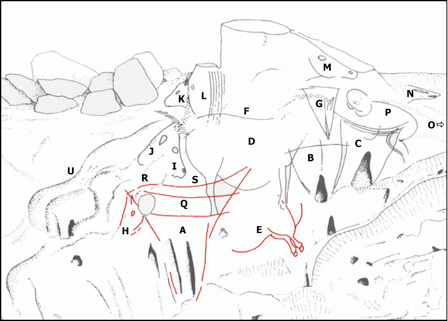
- 2012. The Identification of the First Palaeolithic Animal Sculpture in the Ile-de-France: The Ségognole 3 Bison and its Ramifications.
In: Pleistocene Art of the World, edited by Jean Clottes. N° spécial de Préhistoire, Art et Sociétés, Bulletin de la Société Préhistorique Ariège-Pyrénées, LXV-LXVI, 2010-2011. pp. 74-75 and CD pp. 419-461. ISBN 987-2-9531148-3-6
This monograph-length article uses my discovery of the first Paleolithic bas-relief of an animal in the Ile-de-France to open an investigation into the un-noticed complexity of several other examples of Paleolithic art, including ones from such sites as Font-de-Gaume, Laugerie-Basse and Isturitz. It unveils:
• the first known use of decomposed, interactive, "cubist" conventions, which occur in the Guy Martin cave system and are over 15,000 years old (CD 440-446),
• the intentional hiding of secondary readings within more blatant images (CD 446-450), and even
• some of the oldest known figure-ground illusions, which play upon similarities between the contours of bison and mammoths (CD 435-438)
-
-all of which show how premeditated art has been for tens of thousands of years.

Andrew Howley of National Geographic reported on the paper’s revelation of one of the world’s oldest known intentional optical illusions - a sculpture from Canecaude that has eyes on either side of a crescent: an upper one which turns the crescent into a mammoth’s tusk, and a lower one that turns it into a bison’s horn.
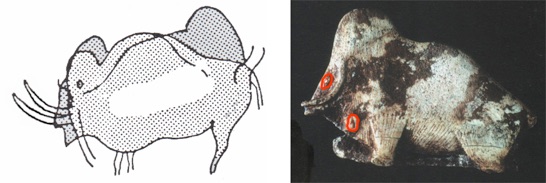
- 2012. Réexamen de Deux Sites à Gravures Piquetées. Milly-la-Forêt (Essonne).
Art Rupestre, Bulletin du GERSAR No 62 (June): pp. 33-38.
A description of this article appears above with the one for “Observations et hypothèses sur le site du Paly” (2013).
-
-2011. Generalised bundles and other perils in developing evolutionary aesthetics. Rock Art Research, Vol. 28 (2): pp 171-174.
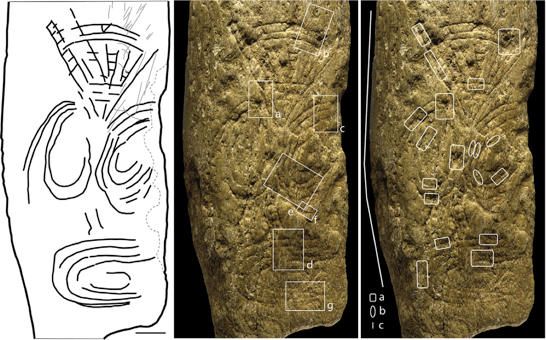
Left: Tracing of the main lines engraved on the bone analyzed in the Journal of Archaeological Science (JAS); grey = recent thin lines; black = smoothed lines depicting the schematic female representation.
Center: location of micrographs presented in Figs. 4 and 5 of the JAS study.
Right: a - area presenting scraping marks; b - area in which lines penetrate concavities produced by weathering of the bone surface; c - lines with sediment residues. Scale = 1 cm. (Figure 3 in the JAS article, Courtesy of my co-author, Dr. Francesco d’Errico).
- 2011. Identification of a possible engraved Venus from Předmostí, Czech Republic.
Co-authored with Francesco d’Errico (Université de Bordeaux and the Institute for Human Evolution at the University of the Witwatersrand) & Martina Lázničková-Galetová (Moravian Museum).
Journal of Archaeological Science (JAS), n° 38, Issue 3 (March): 672-683.
Although I usually write alone, my discovery of the second-known Paleolithic schematic “Venus” was so surprising that it necessitated an examination by the world’s most eminent expert in micro-wear analysis, Dr. Francesco d’Errico, to authenticate the engraving, and the collaboration of the Moravian Museum. Based on microscopic analyses, the paper concluded that an engraving of a woman composed of geometric forms that belonged to René de Poilloüe de Saint-Périer and Raymonde-Suzanne de Saint-Périer could be Gravettian and be by the same hand as the famous Schematic Venus discovered in the 1890s. If so, the two engravings are apparently the only remaining works of one of the oldest and most original of Paleolithic artists – the Master or Mistress of the Schematic Venuses.


- 2010. Supernatural Pregnancies: Common features and new ideas concerning Upper Paleolithic feminine imagery.
Arts & Cultures, Barbier-Mueller Museum, Geneva. pp. 52-75. Published in English, French and Spanish.
This article built a case for a new interpretation of a large part of the Paleolithic feminine canon. This re-interpretation, which could be dubbed the “Prey-Mother” hypothesis, is based on new readings of such iconic works of Paleolithic art as the “Femme au Renne” from Laugerie-Basse and the engraving of a pregnant therianthropomorph following a horse from Étiolles. Although the hypothesis is based on internal evidence, it is also in keeping with women’s known roles in cold-weather hunter-gatherer - or, as I prefer to call them, “hunter-sewer” economies.
The reason I coined this neologism is the term “hunter-gatherers” - which is so appropriate for describing the San in the Kalahari Desert, where food gathered by women provides up to 65% of the calories for their families - is a misnomer, for much of the year, when applied to people living off wild foods in Arctic conditions, since there is very little food to gather during the coldest months, while sewing weather-tight garments becomes essential.
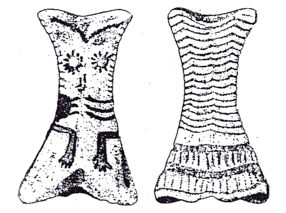
- 2009. Palaeolithic Whistles or Figurines? A preliminary survey of pre-historic phalangeal figurines.
Rock Art Research, Vol. 26, No. 1: 65-82.
Prehistoric phalanges with manmade holes through one side of their shafts have usually been interpreted as whistles. But identical bones are used by several peoples as human effigies — most commonly of women and babies. Distal limb bones with incised or sculpted heads, eyes, arms and vulvas prove that such bones were also interpreted anthropomorphically by Eurasian cultures in the past. The use of phalangeal figurines from central Siberia to Greenland also suggests that the practice spread around the Arctic from ancient sources.
The paper uses ethnographic examples to illustrate a few roles women have played in the region’s cold weather economies and how female effigies reflect such roles, but none of the examples are offered as strict analogies with Paleolithic counterparts. Instead this article goes on to make a case from new internal readings of several prehistoric objects incorporating feminine imagery — including the “femme au renne” (reindeer’s woman) from Laugerie-Basse and an engraving from Étiolles — that some ancient feminine images reflect a vision of women in keeping with the division of labor in northern “hunter-sewer” subsistence models. Economic necessities might partly explain how pregnancy and compact feminine effigies have been viewed ideologically in cold Eurasian areas for millennia.
Finally, the possible existence of perforated phalanges from the Middle Paleolithic and even earlier is noted and a protocol of tests is suggested for determining whether their holes are anthropogenic or natural. If any of the holes in these older specimens turn out to be manmade, then the conclusion that prehistoric perforated phalanges are likely to be figurines will have to be extended to those made by archaic humans like Neanderthals.
- 2008. Are Neanderthal Portraits Wrong? Neanderthal adaptations to cold and their impact on Palaeolithic populations.
Rock Art Research, 2008, Vol. 25, No. 1: 101-116.
This paper predicted that modern lineages from outside sub-Saharan Africa would have a small admixture of Neanderthal genes (up to 4%, as it turns out, from the latest analysis of the Neanderthal genome) from contact with gracile Levantine Neanderthals, but would have almost none from more robust cold-weather Neanderthals to the north. The discovery that non-African lineages have some Neanderthal genes is not nearly as surprising, given the existence of fossils that show some hybridization, as the fact that all those lineages apparently have about the same amount of Neanderthal genes! This suggests that the genes entered modern genomes after the root population of anatomically modern humans (AMHs) had left Africa around 70,000 years ago, but before it had split into separate Eurasiatic and Australian branches, during the brief period when AMHs were still limited to the relatively warm Middle East.
What’s even more surprising is that the descendants of branches that expanded northwards after the initial contact with Neanderthals did not continue to accumulate their genes to a significant degree, since some of those branches continued to have contact with our archaic cousins tens of thousands of years after AMH populations, which stayed around the Indian Ocean. That should have been plenty of time for Caucasians, for example, to acquire a much larger dose of Neanderthal genes. But Europeans have only a little more Neanderthal inheritance than do Polynesians, Australian Aborigines, or American Indians. What could have prevented northern Moderns from adding significantly to their Neanderthal inheritance once they began encountering cold-weather Neanderthals rather than warm-weather ones?
The answer probably lies in the difference between the bones of Levantine Neanderthals, which are fairly gracile, and their cold-weather cousins, which are much more robust. They are so different that the two Neanderthal populations should probably be divided into two races or even sub-species: a Middle-Eastern one adapted to temperate conditions and the other to "hyper-arctic" conditions involving severe wind chill factors.
If the osteological and other analyses detailed in this paper are correct, then the northern Neanderthal population must have had more extreme thermoregulatory adaptations than the southern one, which would have been adapted to almost the same range of temperatures as the even more gracile AMHs coming out of Africa. Just as the similarity between the thermo-regulatory controls of southern Neanderthals and AMHs could explain why they could occasionally hybridize, the different biological approaches to temperature of AMHs and northern Neanderthals could explain why there is so little evidence that they cross-bred.
I hypothesized that the only way for AMHs and cold-weather Neanderthals to maintain such different thermoregulatory adaptations would have been for each population to have its own conservative sexual preferences. AMH preferences would have maintained whole-body cooling systems based on sweat and bald bodies, which could only be insulated against glacial conditions with seamed clothing, while northern Neanderthal preferences ensured that each new generation was equipped with bodies that grew winter insulation in the form of sub-cutaneous fat and fur, which would have required the addition of nothing more than draped clothing. The fact that AMHs and northern Neanderthals were so invested in such contrasting thermoregulatory solutions would have locked them into preferences that prevented much hybridization and the survival of many hybrids.
But the corresponding fact that neither AMHs nor the Levantine Neanderthals they encountered before 60,000 years ago were invested in biological adaptations to extreme cold - with their incompatible sets of sexual cues - would have opened the path to limited cross-breeding in the Middle East, just as the latest genetic results have demonstrated.
Recent popular articles:
1)Aug. 27, 2014: Op-Ed: The Automatic Association of Lyme Disease with deer may be Flawed. The Martha’s Vineyard Times (MV Times).
2)Oct. 25, 2012: These Walls Can Talk, Chilmark Home Reveals Ancient Drawings. Vineyard Gazette.
A call-to-arms to save one of the earliest post-contact portrayals of life in New England by American Indians.
3) Oct. 24, 2012: P.G. Harris of Chilmark Dug Deep into the Island Past. The Martha’s Vineyard Times. (This article is basically the same as the one above.)
Recent articles by others about my work:
-
1)2020. “Exhibit of Rare African Statues Depicts Cross Cultural Tragedies.” By Noah Asimov, Vineyard Gazette, September 17, 2020.
-
2)2018. “Gardens of Love: Duncan Caldwell.” Valerie Sonnenthal’s article about the garden I built for my wife, Nancy Caldwell, appeared in The Martha’s Vineyard Times on Sept. 12, 2018.
-
3)2017. “Native Insight: The unknown, ever so enticing.” The Greenfield Recorder. July 7, 2017. The author, Gary Sanderson, tells how he showed me everything from mountaintops to creek bottoms as we looked for prehistoric engravings and other evidence of ancient humans around the Sugarloaf Clovis site near Deerfield, Massachusetts.
-
4)2016. “The Grimaldi Figurine: A Return of Sorts.” By Jeffrey Quilter, Director of the Peabody Museum of Archaeology and Ethnology. This article on pages 7 and 8 of the Fall issue of the journal, In Situ: News and Events of the Harvard Standing Committee on Archeology, tells about my efforts to re-locate a Gravettian “venus” figurine, which I’d asked various people at the museum to find in its reserves for a decade. Luckily, I was finally fortunate enough to speak with Dr. Quilter, who made the search for the statuette, which is known as the “Janus” or “Woman with the Perforated Throat”, a priority, and the hunt was ultimately successful. I encourage everyone to go see the sculpture, which will be given pride of place during the celebration of the museum’s 150th anniversary.
-
5)2016. “A Journey Into Centuries of Congolese History.” By Alex Elvin. An article in the Vineyard Gazette (Aug. 15) about the implications of the attachments on an exceptional nkisi n'kondi modelled on a soldier during the First World War. The large Bakongo statue has hundreds of attachments, including: A) seven types of canisters, which seem to be grenades and a trench mortar, B) the regulatory knob from a particularly bright type of German military lantern, and C) a trumpet, which was sold by a company in Manhattan that furnished instruments to brass bands accompanying the American army to France. The most plausible explanation for the assemblage is that Congolese veterans brought the objects back from Europe, where they had fraternized and fought with musicians from African American bands like the Harlem Hell Fighters. The consequences of those contacts in the midst of fighting in which black men were armed by whites to kill other whites and exposed to the barbarity of their 'civilizing' masters had political and cultural consequences, which rippled all the way from the Marne to places like Memphis and Brazzaville.
-
6)2016. “Squibnocket History Evokes Glacial Time.” By Alex Elvin. An article in the Vineyard Gazette (Jan. 28) about the prehistory and geological history of Squibnocket Beach and Point on Martha’s Vineyard.
-
7)2014. “Fontainebleau - Le menhir de la discorde.” By Jacques Daniel. Archéologia (March, No. 519, pp. 8-9). This report outlines the themes of an article entitled “An historic sign, possible Mesolithic menhir, DStretch, and problems in dating rock art to the Sauveterrian in the Massif de Fontainebleau”, which appeared in the Journal of Archaeological Science (JAS, Vol. 42: 140-151) the month before. Despite the fact that the report in Archéologia contains a few mistakes*, its gist is correct.
-
8)2013. “Man for the Ages.” By Jim Miller. Martha’s Vineyard Magazine, August: 16-18. A brief biography. (The photos are still visible in the PDF version, which you can see here: Man for the Ages).
-
9)2012. “The Original Rock Music.” Oceanus, Woods Hole Oceanographic Institution, vol. 49, 2 (spring):53. The Woods Hole Oceanographic Institute announced the discovery of a possible new class of prehistoric musical instruments in northeastern North America - portable cylindrical lithophones.
-
10)2010. “World’s Oldest Optical Illusion Found?” By Andrew Howley. NatGeo News Watch (National Geographic), December 22. Andrew Howley reported on my description of one of the world’s oldest known intentional optical illusions - a sculpture from Canecaude that has an eye on either side of a crescent: an upper one which turns the crescent into a mammoth’s tusk, and a lower one that turns it into a bison’s horn.
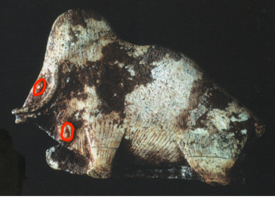
* Here are the three inaccuracies. Although the report says that the monolith in the grotte à la Peinture apparently fell into its present position because of freezing and thawing, researchers have always suggested that it was actually moved voluntarily from a ledge several meters away along the left wall of the cave. Two, although the report says that there is one line of vertical text on the monolith, there are at least five lines of letters, and all the letters in them are arranged horizontally in relation to each other, not vertically. The third inaccuracy is that the excavator, Hinout, showed the monolith as being surrounded by two Mesolithic layers. In fact, his cross section shows the boulder lying on a Mesolithic layer but surrounded horizontally by a Neolithic one. Despite these discrepancies, the gist of the report about our JAS article is basically correct.
Some recent public lectures:
April 19, 2016: The Magic Trumpeter: An exceptional BaKongo statue and its links with World War I. Détours des Mondes, Paris
Feb. 19, 2015: Réétudier les collections muséales de Préhistoire : pourquoi ? Musée de l’Homme, Paris.
April 17, 2014: Réétudier les collections muséales de préhistoire : pourquoi ?
Institut de Paléontologie Humaine, Muséum national d’Histoire naturelle, Paris
January 30, 2014: La datation des pétroglyphes de la forêt de Fontainebleau.
SAGA, Muséum national d'Histoire naturelle
Dec. 12, 2013: Designing Time Machines: Reflections on the creation of archaeology & ethnology museums.
Ecole Nationale Supérieure d'Architecture, Nantes
Oct. 3, 2013: Decoding the Adena Tablets: New Interpretations of the "Mound Builder" Tablets.
University Seminar on the Arts of Africa, Oceania, and the Americas
Columbia University, New York.
Aug. 8, 2013: The Birth of Our Genus: The tool that changed us from head to foot.
Aquinnah Public Library, Massachusetts
May 31, 2013: Recent Megalithic Discoveries in the Massif de Fontainebleau.
International Rock Art Congress, Albuquerque, New Mexico
May 20, 2013: The Saharan Origins of Ancient Egyptian Royal Symbols.
The Explorers Club, 46 East 70th Street, NYC
May 11, 2013: Western Saharan Sculptural Families and the Possible Origins of the Osiris-Horus Cycle.
Musée National de Préhistoire, Les Eyzies-de-Tayac, Dordogne
May 3, 2013: Réétudier les collections muséales de préhistoire : pourquoi ?
Institut de Paléontologie Humaine, Muséum national d’Histoire naturelle,
Paris
May 30, 2012: Re-examining Museum Prehistory Collections in Search of Fresh Perspectives.
Institut de Paléontologie Humaine, Muséum national d’Histoire naturelle
Sept. 8, 2011: Voyage to the Sun: How the Egyptians Retrieved Solid Sunlight for Tutankhamun’s Tomb.
Planetarium, California Academy of Sciences, San Francisco, California.
Sept. 6, 2011: The Mirage of Simplicity in Paleolithic Art.
San José State University (SJSU) Graduate School of Art + Design
San José, California.
Aug. 11, 2011: Correcting Neanderthal Reconstructions.
Aquinnah Public Library, Massachusetts
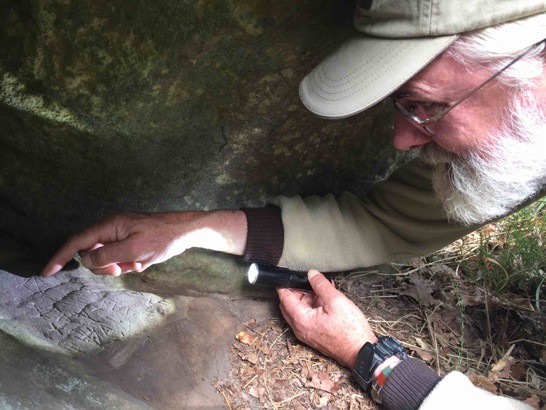
My friend, Richard Lebon, found this engraving, which is called Vente Bourbon 4, in the Forêt de Fontainebleau at the same instant that I found Vente Bourbon 3 nearby. GERSAR is responsible for the discovery, inventorying and protection of about 2,000 sites in the region, including these two.
(Courtesy of Henrik Otterberg)
Archaeological conservation:
The members of GERSAR (Groupe d'Etudes, de Recherches et de Sauvegarde de l'Art Rupestre), which is dedicated to the discovery, description and protection of the rock art of the Yonne, Massif de Fontainebleau, and the rest of northern France, made me its representative to IFRAO (The International Federation of Rock Art Organisations) on Feb. 29, 2020.
I’ve tried to fulfill my duties by
-
-providing help with the organization of the first IFRAO World Congress in the Parisian area,
-
-facilitating site visits by our foreign colleagues and counterparts,
-
-soliciting advice from other conservation organizations about the best ways of dealing with the incredible challenges that GERSAR faces in protecting hundreds of sites near millions of people,
-
-and helping GERSAR members prepare articles for English-language peer-reviewed journals such as Rock Art Research.
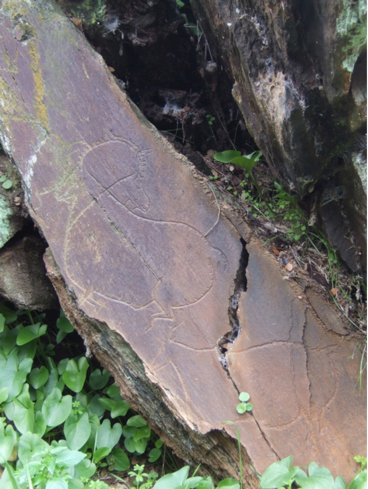
A male ibex with his head shown in two positions, as if he were turning to watch the female behind him. Quinta de Barca, opposite Penascosa. Côa Valley.
(copyright 2010 Duncan Caldwell)
I founded Prehistoric Art Emergency in May 1995, which initiated, centralized and forwarded international petitions against the destruction of the richest ensemble of open-air Upper Paleolithic art in Europe by a dam project in the Côa Valley of Portugal. This effort contributed to the decision to make the entire zone at Foz Côa an archaeological park – after half of the $300,000,000 construction budget had already been spent on making coffer dams and turbine tunnels.
Field campaigns & expeditions:
2013: Mission Fontainebleau.
As the person who had found and described engravings at three Neolithic art sites in the Massif de Fontainebleau and shown that the zone might be one of the most important concentrations of early-to-mid Neolithic iconography in France, I served as the host and guide for an expedition from the CNRS Archaeological Research Laboratory at the Université de Nantes to study the sites in June 2013. This week-long effort to record the petroglyphs using complementary photogrammetric and laser recording methods was carried out by Serge Cassen*, Laurent Lescop** and Valentin Grimaud***, and resulted in a spectacular new discovery, which we described jointly.
* Directeur de recherche, CNRS, Laboratoire de recherches archéologiques [LARA], Université de Nantes, 44312 Nantes,
** Professor, École nationale supérieure d’architecture de Nantes, Laboratoire GERSA,
*** LARA and GERSA
These three researchers work under the auspices of a European program called “JADE : Inégalités sociales et espace européen au Néolithique : la circulation des grandes haches en jades alpins”, of which Mission Fontainebleau is a sub-set.
2009 (Nov.): Prospection in Mali.
Recent political turmoil in Mali has prevented me from studying a site, which I found with the help of traditional hunters, in an area without any known rock art from before the last millennium. The spectacular site consists of dinosaur trackways intermixed with artificial ones made by humans. These artificial trackways consists of animal and human prints that have been pecked and ground into the fossil bed. The interesting thing about this discovery, which blends paleontological and prehistoric vestiges, is that the network is partly covered by sand, and crops up elsewhere. I was about to do the mapping, when the zone was invaded by Tuaregs affiliated with el Qaida and became too dangerous. The other problem is that I have never asked anyone for financing, meaning that all my work has been self-financed on a shoestring, which is insufficient for carrying out the kind of group expedition that the study of such sites will entail.
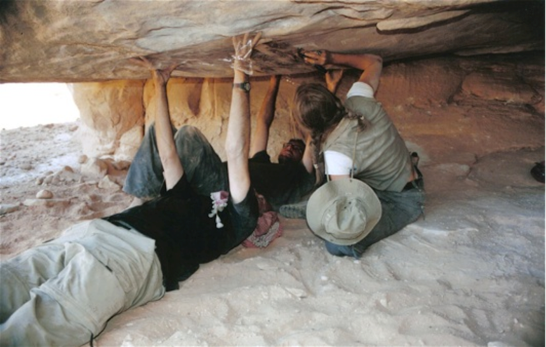
2005 & 2006: Archaeological surveys of the Great Sand Sea and Gilf el Khebir, Egypt.
I spent the first of these expeditions into the eastern Sahara, which I undertook with a single cameraman, collecting GPS data for a three-week expedition the following year. The huge amount of information that we collected during the next expedition, which I organized and led, continues to generate publications by Dr. Luc Watrin, Dr. Emmanuelle Honoré and myself (Rock Art Research, Nov. 2013), which are helping to clarify the ancient cultures of the area and origins of the Neolithic cultures of the Nile.
1995: Archaeological survey of the Côa Valley in Portugal. The results of this clandestine survey, which the government tried to prevent, are described in “Out of Sight, Out of Mind: The Conspiracy to Flood the Seventh Wonder of Prehistory”, which is available on the internet.
1993-2013: Prospection and recording of prehistoric art sites around the Ile-de-France.
I have spent the past two decades prospecting for prehistoric art sites in the Ile-de-France and Yonne with my friend and colleague, Laurent Valois – who has become the editor of Art Rupestre. Together, we have discovered hundreds of small engraved caves and rock shelters and helped to create the archaeological inventory for the region, which tells the government where the sites are and what they contain. This confidential inventory is being used by France in its effort to get UNESCO to designate the complex a new UNESCO World Heritage Site.
Exhibitions:
• 2008-2013. Contributor. Musée de Préhistoire de Tautavel.
• 2007-2011. Contributor. Comparative Prehistory Hall, National Museum of the Dominican Republic.
• 2007. Contributor. “Lucy, Histoire d'ancêtres”. Centre Européen de Recherches Préhistoriques in Vallon-Pont d’Arc, France. June 1 – 30 Sept.
• 2006-2008. Organizer. After hearing my proposals for two exhibitions of Paleolithic portable art – one which would have shown many of the genre’s masterpieces, plus a second which would have brought together great feminine imagery - three curators at the Saint Louis Art Museum expressed an interest in exhibiting up to 280 objects, on the condition that I find a second venue. When the National Archaeological Museum of Catalonia (and its sponsor, the Caixa Foundation) accepted the large show, with objects from institutions like the Louvre and National Museum in Athens, the St. Louis Museum withdrew its support because of a construction project, and reduced its request to 35 to 50 objects.
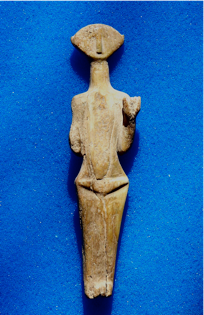
Despite my change in focus, the director of the Pulitzer Museum, Kristina Van Dyke, visited my home for two days in 2012 to discuss the possibility of having the “Venus” show come to her museum at some indefinite point in the future, so there may still be hope. In the meantime, the British Museum has basically exhibited the first of the two shows I was planning, under the title “Ice Age Art: Arrival of the Modern Mind” (Feb. – May 2013).
-
•2006. Contributor. “Ancient Art of the Cyclades”. Katonah Museum of Art. The curator, Pat Getz-Gentle (Getz-Preziosi), is shown below, examining Neolithic feminine figurines.
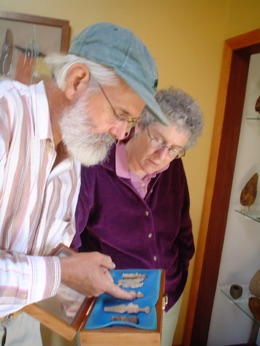
Pat Getz-Gentle (Getz-Preziosi) and I examining
Neolithic feminine figurines
-
•1999. Contributor. “Maroc - Mémoire de la Terre” (Morocco - Memory of the Earth, 1999) at the Muséum National d’Histoire Naturelle in Paris.
I hope there will continue to be many opportunities for collaboration around the world.
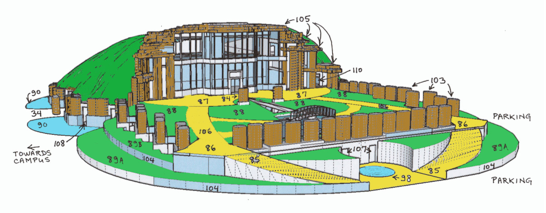
Museum Design
(architecture, interior design & landscaping):
Mount Olive College adopted my design for an encyclopedic museum focused on linking the deep past with the present and future in 2008, before abandoning the project after the stock market crash. The thoroughly modern building, which was supposed to be called the Wellspring Museum, would have incorporated aspects of a tumulus, rock shelters and megalithic alignments – with a stream cascading from a glass channel, which bisected the roof and illuminated one of the terraced galleries below. Although the museum will probably never be built, I was invited to give a lecture entitled “Designing Time Machines: Reflections on the creation of archaeology & ethnology museums” on this and other designs to doctoral students at the Ecole Nationale Supérieure d'Architecture in Nantes, France on Dec. 12th, 2013.
Editorial work:
Most of my referee work is for Rock Art Research.
Dr. Hany Hanna of the Egyptian Supreme Council of Antiquities also asked me, in my capacity as a specialist in Saharan prehistory, to be a member of the Editorial Committee of The International Conference on the Heritage of the Naqada and Qus Region.
Graduate level teaching in prehistory:
I have taught graduate students at the Muséum National d’Histoire Naturelle in Paris for the last five years and sit on juries for their oral examinations (Module d’Ecole Doctorale, Département “Homme, Nature, Société”, M.N.H.N. QP26).
Coastal engineering related to increased erosion
due to sea-level rise:
After two teams of coastal engineers, who were working for adversarial landowner groups, had drawn up incompatible plans for raising and re-routing a strip of road between the ocean and a tidal pond, some of the stakeholders from both sides asked me to search for the studies’ factual and methodological flaws, and propose a solution which might satisfy everyone. This led to several reports, including one that is listed on the Chilmark government website. Steve Myrick mentioned both these reports and an earlier suggestion concerning artificial reefs in an article entitled “No bridge, no dune, but causeway recommended for Squibnocket”, which appeared in the MV Times. Alex Elvin approached my analyses from a different perspective in an article called “Squibnocket History Evokes Glacial Time”, which appeared in the Vineyard Gazette.
Honors:
As a result of my paleoanthropological articles on Neanderthal soft tissue reconstructions, research on New England’s paleo-fauna, extensive re-interpretation of prehistoric feminine imagery, and other work, I was elected a Fellow of the Marine and Paleobiological Research Institute in 2009 and an International Fellow of the Explorers Club in 2012.
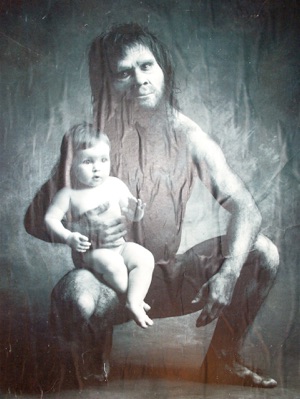
© 2009 onwards Duncan Caldwell
Please click on the following thumbnail photos, which I’ve used as icons, to see the web pages or PDFs described in the captions.
This essay corresponds to the culminating lecture of a symposium entitled “Uses and Abuses of Thoreau at 200” held at the Department of Literature, History of Ideas, and Religion of the University of Gothenburg in Sweden on May 3rd & 4th, 2018.
This is the annex/sequel to ‘Mind Prints, Arrowheads, the Indians & Thoreau’ (2018).
This article is the first of two about engravings at a megalithic complex around a menhir, which is known variously as le menhir du Paly, la Pierre Droite and la Pierre du Paly, where I discovered a face on the east face and fingers and other anthropomorphizing features of a motif on the west face that had previously been interpreted as a Christian cross. These observations, which are split between the two articles, proved this article’s contention that the motif was actually a cruciform Neolithic “idol”. The paper goes on to describe a Neolithic frieze, which I found in a nearby cave (Butte de Châtillon 5). The panel contains such unique symbols as upside-down axes and an inverted axe surmounted by a U-shaped motif. If the U is like the ones that were engraved in dolmens, where they are often accompanied by mounds which seem to symbolize breasts, then it probably represents horns or the necklace of a Neolithic “goddess”. (Art Rupestre : Bulletin du GERSAR n° 62 - juin 2012: 33-38)
The Foz Coa / Coa Valley prehistoric rock art scandal
Prehistoric Art Emergency & Foz Coa / Coa Valley home page
Archaeological tours
A Murder, Bombing, and Trip to “Dolmens”
Key words: Human evolution; Neandertal extinction; The Neanderthal insulation hypothesis; Baby sling adaptations; The baby-sling hypothesis for human body baldness, Paleolithic venus / venuses; The “prey-mother” hypothesis - A new interpretation of Paleolithic feminine imagery; Archaeological & prehistoric art cave tours; Testimonials; Prehistoric phalangeal figurines; Neanderthal extinction; Alan Dershowitz; Dan Burstein, Secrets of the Code; Marine and Paleobiological Research Institute (MPRI); New Dominion Pictures; GREPAL; Gaumont; Wellspring Museum; Neanderthal / Neandertal adaptations and extinction; Architecture & landscape design; Neanderthal diet; Neanderthal behavior; Evolution of large brains; Balkan prehistory; Vinca, Lepenski Vir; Martha’s Vineyard Community Services Possible Dreams auction; Robert Bednarik; Rock Art Research; Susiluola (Wolf) Cave, Lappfjärd, Finland; paleontology museum in Paris / Montmartre quarries; Neolithic mortuary monuments; Dolmens; Prehistoric French sites; Cave art; Prehistoric art; World’s oldest optical illusion;
